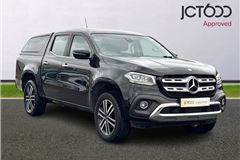Mercedes-Benz X-Class (2018 – 2020) Review
Mercedes-Benz X-Class (2018 – 2020) At A Glance
Good to drive, practical and unashamedly expensive, the Mercedes-Benz X-Class adds a touch of premium refinement and exclusivity to the rugged world of one-tonne pick-ups.
The air of exclusivity is evident from the moment you first clamp eyes on the Mercedes-Benz X-Class; the front end is dominated by a huge three-pointed star, which sits in the middle of an equally large and imposing grille. Make no mistake, this looks every inch a Mercedes-Benz - albeit one that’s based on the underpinnings of the Nissan Navara.
Indeed, peer under the metal of the X-Class and you’ll find that the platform, engines and transmissions are all shared with the Navara. This means the X-Class is built for hard graft. It also gets the same sophisticated suspension set-up as the Nissan, which means it has a smooth, car-like ride quality.
When it comes to shifting huge loads, the X-Class matches the best with a one-tonne payload and 3.5 tonne braked towing capacity. It has some neat features too, with a built-in bumper step - that allows you to load/unload without opening the tail gate - and a brake light that doubles up as a worklight to illuminate the loadbed at night.
The X-Class is great to drive on the road, with car-like handling and supple suspension that wouldn't feel amiss in a premium family SUV. The steering, for example, is smooth and precise, while engine, road and wind noise has all been reduced to a hushed rumble. What’s more, if you want to head off-road, there is a whole raft of tech at your fingertips, including a four-wheel drive system that can be activated on the move via a rotary dial situated above the gearstick.
The cabin is high in quality for a pick-up, but not on par with the Mercedes-Benz car range. And nor should it be, owing to the fact that the X-Class is effectively a working vehicle. This means hard wearing plastics are common, but there are also plenty of premium touches, with leather seats, wood trims and stitched dashboard covers.
Given the shared tech, it would be easy to criticise the X-Class as an expensive, facelifted Navara; however, this would be extremely unfair because the Mercedes-Benz genuinely feels very different to the Nissan. Good to drive, refined and stylish, it's one of the best pick-ups on the market. Admittedly, the price point is huge, but if you can afford it then Mercedes-Benz X-Class won’t disappointed.
Driving the Mercedes-Benz X-Class (2018 – 2020)
Like its Nissan counterpart, the Mercedes-Benz X-Class is powered by a Renault-sourced Euro6 2.3-litre turbodiesel. Available in two outputs - 163PS or 190PS - both will tow a braked trailer weighing up to 3.5 tonnes and shift payloads up to one-tonne. A Mercedes-Benz-built V6 will be added to the range in mid-2018 and feature 258PS, which should lay the groundwork for a performance-focused AMG model in 2019.
For everyday driving, the 2.3-litre diesel is more than sufficient; the entry-level 163PS version develops 403Nm of torque from 1500rpm, which provides plenty of low-down pull across the six-speed manual gearbox. Capable of covering 0-62mph in roughly 12 seconds, the 163PS engine is fine for motorway driving and light off-roading, but can feel a little lethargic when tackling steep inclines or carrying heavy loads.
In comparison, the 190PS engine - which reaches 62mph from a standstill in 11 seconds - is much better for maximising the X-Class’ gargantuan towing ability, as well as thundering up hills, with 450Nm of torque and a smooth seven-speed automatic transmission fitted as standard.
Mercedes-Benz claims to have spent considerable time improving refinement and handling. And the hard work has clearly paid off because the X-Class feels like an upmarket and comfortable family SUV on the road. Indeed, the light and responsive steering makes it surprisingly easy to guide the vehicle's 2.2 tonnes through a series of twisty bends. The suspension doesn’t crash or pitch sideways on rough roads either, even when the vehicle is unladen.
Both the throttle and brake pedals are light and require a deft touch to operate. This means a light foot motion is all that’s required to increase momentum for overtaking or cutting speed for cornering. The smooth steering also makes parking painless, with most models getting front and rear parking sensors as standard. In our opinion, the X-Class is one of the best pick-ups for everyday comfort and refinement.
Like the Navara, the X-Class uses a selectable four-wheel drive system; this means it runs in rear-wheel drive until you turn the rotary dial above the gearstick to active all-wheel drive. High and low ratios are also activated by the big dial and there is a switch that allows the vehicle to automatically control its speed down a steep incline. A lockable differential for the rear axle is available as a payable option.
The only area where the Mercedes-Benz falls a little flat is on fuel economy. The 163PS engine, for example, will return an official 37.1mpg. Advertised economy for the more-powerful 190PS drops to 35.7mpg, which is a long way short of the 44.8mph that Nissan advertises for the four-wheel drive Navara.
Mercedes-Benz X-Class (2018 – 2020) interior
Unlike its rivals, the Mercedes-Benz X-Class doesn't get much choice when it comes to bodystyles. The X-Class is only offered as a double cab; this is down to the fact that Mercedes-Benz is openly pitching its pick-up to SUV buyers and professionals who want a working vehicle that will double up as classy, family transport at the weekends.
There are three trim levels - Pure, Progressive and Power - and the basic version is aimed at tradespeople, with unpainted plastic bumpers, 17-inch steel wheels, plastic flooring and hardwearing cloth seats. The Progressive trim takes things up a notch, with body coloured bumpers, alloy wheels, automatic headlights, climate control and heated door mirrors.
Mercedes-Benz expects most buyers to choose the X-Class in Power trim and this is the best-equipped of all, with 18-inch alloys, LED headlights, keyless start and leather seats. However, there’s no reach adjustment for the steering wheel on any of the X-Class variants, which can make it tricky to find a natural driving position.
Like the Nissan, the big Mercedes can carry payloads weighing one-tonne. Towing capacity is also huge, with the X-Class capable of lugging 3.5 tonnes when hooked to a braked trailer. If the standard 90-degree tailgate opening is not enough, the X-Class can be ordered without the rear bumper to allow the tailgate to open to 180 degrees.
In terms of size, the loadbed is designed in such a way that a Euro-pallet can be loaded straight between the wheel arches. The loadbed is 1587mm long and 1560mm wide and the third brake light doubles up as a smart LED light that will illuminate the whole loadbed - always handy for loading/unloading at night. There is also a built-in step in the rear bumper makes it easy to lift items out of the back, without lowering the tailgate.
The interior is upmarket by pick-up standards, but buyers expecting an opulent Mercedes-Benz car experience might be a little disappointed with the abundance of hard and scratchy plastics found in the doors and lower parts of the dashboard. That said, the interior is well made and durable.
High spec models get a smart leather stitched finish to the upper part of the dashboard, along with a seven-inch infotainment screen that's operated via a touch pad. The cabin itself is large, although fitting five adults will be a squeeze owing to the narrow middle seat in the rear.
Model History
- July 2017: Mercedes-Benz reveals X-Class
- October 2017: Mercedes-Benz X-Class available from £27,310 +VAT
- August 2018: X 350 d 4Matic launched
July 2017
Mercedes-Benz reveals X-Class
The X-Class can haul a payload of up to 1.1 tonnes. That is enough to transport 17 full 50-litre barrels of beer in the cargo area. Able to tow up to 3.5 tonnes, it can also pull a trailer containing three horses or an eight-metre yacht.
In terms of width, the load bed is designed in such a way that a Euro-pallet can be loaded straight between the wheel arches. The X-Class is the only mid-size pickup to be equipped with lighting in the cargo area as standard. The third brake light contains LED lights which illuminate the whole load bed. Operation is by a switch in the centre console. As soon as the ignition is switched on, those lights turn off automatically. A 12-volt socket to power additional equipment such as compressors, for example, is also part of the standard equipment in the load bed.
|
Dimensions of the X-Class |
|
|
Vehicle length |
5340 mm |
|
Vehicle width |
1920 mm |
|
Vehicle height |
1819 mm |
|
Wheelbase |
3150 mm |
|
Load bed length |
1587 mm |
|
Load bed width |
1560 mm |
|
Load bed height |
474 mm |
|
Maximum payload capacity |
1042 kg |
|
Braked towing capacity (depending on engine and equipment) |
1650–3500 kg |
As from its market launch, there are two powerful and efficient four-cylinder engines to deliver spirited performance. The high-torque common-rail diesel drive system with a displacement of 2.3 litres is available with a choice of two power outputs. In the X 220 d with single turbocharger it generates 163PS and in the biturbo X 250 d 190PS.
October 2017
Mercedes-Benz X-Class available from £27,310 +VAT
The Mercedes-Benz X-Class starts from £27,310 excl. VAT. All UK vehicles are doublecab, with 4MATIC selectable all-wheel drive and low-range, drive selection mode, with double wishbone front suspension, and multi-link rear suspension, all as standard.
The entry-level X-Class PURE model is only available with the six-speed manual transmission 220 d 4MATIC engine, and offers a rear bumper with integrated step, halogen headlights and a radiator grille with matt black finish.
Inside, the PURE model offers a manually adjustable driver and passenger seat in Tunja black fabric upholstery, with a large storage compartment in the centre console, incorporating an armrest and cupholder. The model also offers semi-automatic air-conditioning with high gloss black details in the air vents. X-Class PURE models are offered with 17-inch steel wheels as standard.
The mid-level X-Class, which is £1200 excl. VAT above the PURE model, is offered with a choice of either the 220 d 4MATIC engine, or the uprated 250 d 4MATIC engine.
The PROGRESSIVE model line also offers painted bumpers with a simulated under guard in matt black; aluminium door sills featuring ‘Mercedes-Benz’ lettering; chrome door handles; load securing rail system; heated exterior mirrors; and a radiator grille with iridium silver matt finish.
Inside, the model comes with black fabric upholstery and an aluminium trim, with automatic dimming interior mirror with integrated compass function, illuminated sun visors, lighting for the front footwell and exit lamps, and chrome air vents.
X-Class PROGRESSIVE models are offered with 17-inch six-twin-spoke light-alloy wheels in vanadium silver as standard.
The high-level X-Class, which is £3500 excl. VAT above the PROGRESSIVE model, is offered in conjunction with the 250 d 4MATIC engine only, and features painted bumpers with simulated under guard in chrome; a rear bumper in chrome with integrated step; fog lights with chrome surround; shoulder line trim strips in chrome; LED high-performance headlights with cleaning system; LED tail lights; electrically folding exterior mirrors; and KEYLESS GO, all as standard.
Inside, the POWER line comes with eight-way electrically adjustable driver and front passenger seats as standard, with ARTICO leather and DINAMICA microfiber upholstery, with an ARTICO leather dashboard with topstitching, complimented by a black, high-gloss interior trim. X-Class POWER models are offered with 18-inch six-twin-spoke light-alloy wheels in himalaya grey, as standard.
August 2018
X 350 d 4Matic launched
Priced from £38,350 excl. VAT, with first deliveries expected in November 2018. The six-cylinder diesel engine has a power output of 258PS and a maximum torque of 550 Nm.
All UK vehicles are doublecab, with 4MATIC permanent all-wheel-drive and Dynamic Select, 7G-Tronic Plus automatic transmission.
The 350 d 4MATIC is offered in conjunction with the high-level POWER equipment line only, and features painted bumpers with simulated under guard in chrome, a rear bumper in chrome with integrated step, fog lights with chrome surround, shoulder line trim strips in chrome, LED high-performance headlights with cleaning system, LED tail lights, electrically folding exterior mirrors and KEYLESS GO, all as standard.
Inside, the X 350d 4MATIC comes with eight-way electrically adjustable driver and front passenger seats, which are heated, as standard, along with a leather steering wheel with gearshift paddles and cruise control, ARTICO leather and DINAMICA microfiber upholstery, and an ARTICO leather dashboard with topstitching, complimented by an aluminium interior trim. It is also offered with 18-inch six-twin-spoke light-alloy wheels in himalaya grey and with heated washer fluid jets as standard.

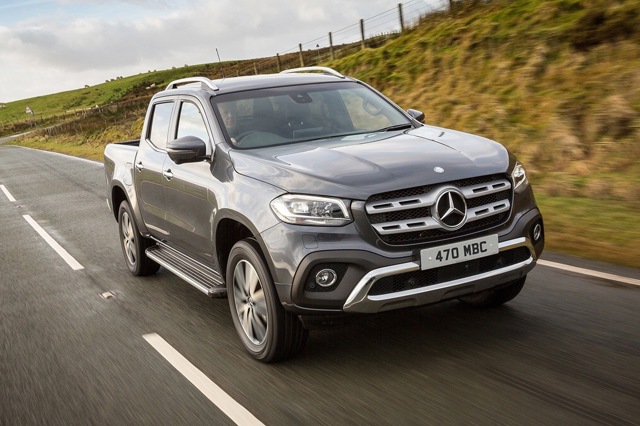
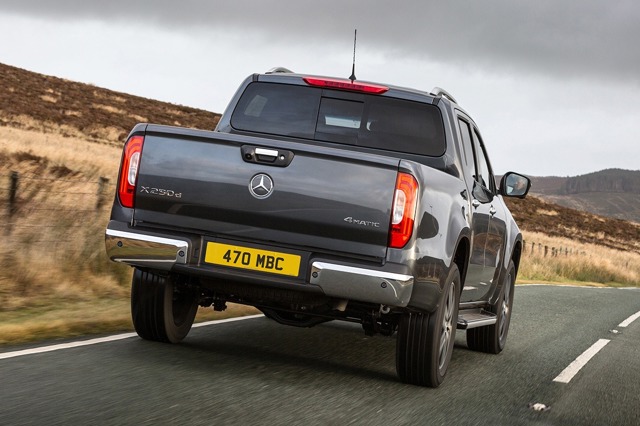
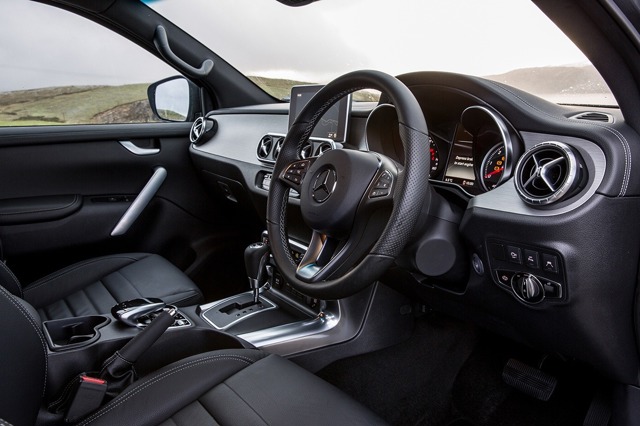
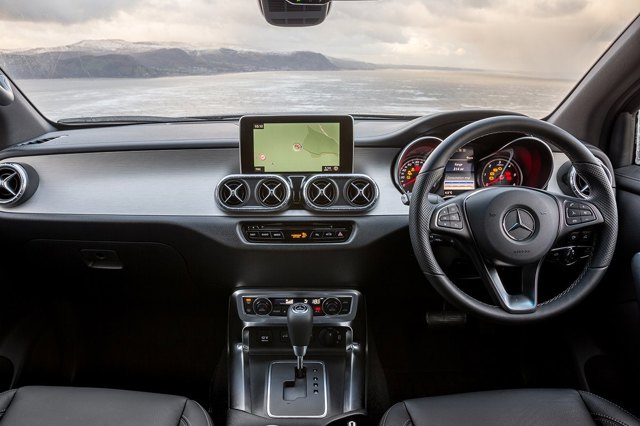
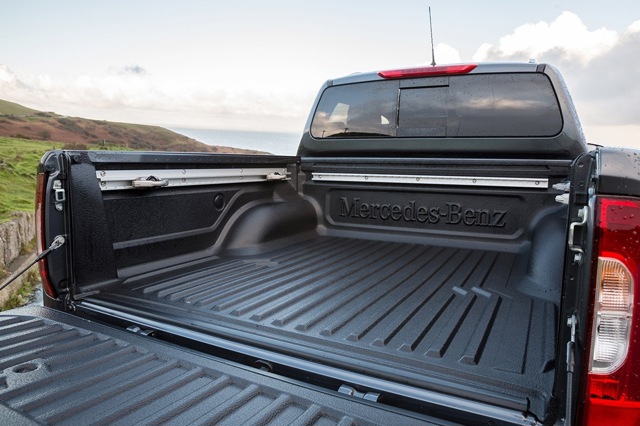
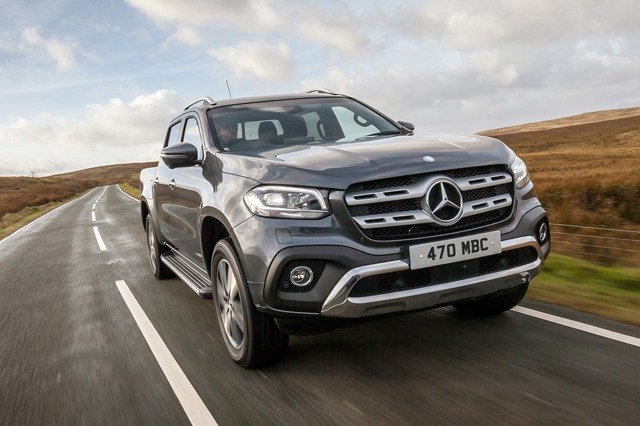


 Premium pick-up with car-like refinement and comfort, quiet engines, 3.5 tonne towing capacity.
Premium pick-up with car-like refinement and comfort, quiet engines, 3.5 tonne towing capacity.
 Expensive to buy new, high running costs, interior quality not quite up to Mercedes-Benz car standards.
Expensive to buy new, high running costs, interior quality not quite up to Mercedes-Benz car standards.
